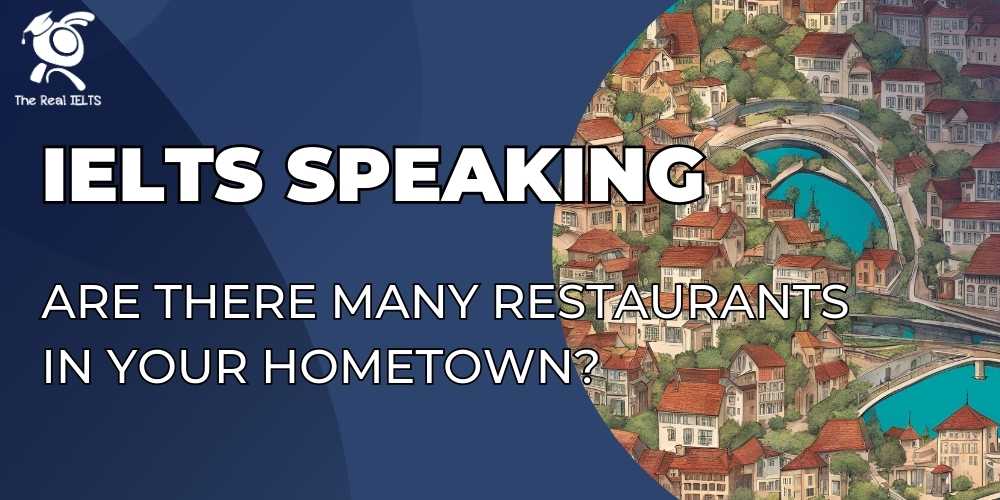IELTS Speaking Part 1 thường xoay quanh các chủ đề quen thuộc như cuộc sống hằng ngày. Với câu hỏi “Are there many restaurants in your hometown? What kind of food do they serve?”, bạn sẽ học cách trả lời tự nhiên, phong phú, sử dụng từ vựng và cấu trúc câu hiệu quả để gây ấn tượng với giám khảo.
Đọc thêm các bài luyện thi IELTS khác.
Đọc thêm câu hỏi khác tại: IELTS Speaking Part 1: Introduction and Interview chủ đề Your hometown.
Đọc thêm: IELTS Speaking: What is the cost of living in your hometown like?
Câu trả lời IELTS Speaking: Are there many restaurants in your hometown? What kind of food do they serve?
Ví dụ 1
Introduction
Hanoi, my hometown, is a bustling city that boasts an incredibly vibrant culinary scene. There are countless restaurants scattered throughout the city, ranging from small, family-run eateries to luxurious, high-end dining establishments. Food is deeply ingrained in the culture of Hanoi, and dining out is a common pastime for locals and tourists alike.
Geographical Description
Hanoi is divided into several districts, each offering its own unique selection of restaurants. For example, the Old Quarter is famous for its traditional street food, while areas like Ho Tay, or West Lake, are home to more upscale restaurants with stunning views. No matter where you go in the city, you’ll find a mix of cuisines and dining styles to suit every taste and budget.
Cultural Aspects
The food culture in Hanoi reflects the city’s diversity and deep-rooted traditions. Many restaurants specialize in Vietnamese cuisine, offering dishes like pho, a fragrant noodle soup, and bun cha, grilled pork served with rice noodles and fresh herbs. Street vendors selling banh mi sandwiches and fresh spring rolls are equally popular. However, Hanoi has also embraced international cuisine. Restaurants serving Italian, Korean, Japanese, and even Middle Eastern food have become increasingly common, reflecting the city’s growing cosmopolitan vibe.
Historical Background
Hanoi’s food scene has a rich history. Some restaurants in the city have been operating for decades, passed down through generations. For instance, Pho Thin, a small noodle shop, has been serving customers since the 1950s and remains a favorite among locals. These eateries not only serve delicious food but also tell a story of Hanoi’s culinary evolution, from traditional Vietnamese dishes to a modern fusion of flavors.
Economic Activities
The restaurant industry plays a significant role in Hanoi’s economy. It provides jobs for thousands of people, from chefs and waitstaff to food suppliers and marketers. Additionally, the rise of tourism has fueled the growth of restaurants catering to international visitors. This vibrant industry has also led to the emergence of food delivery services, making dining even more accessible for busy city dwellers.
Personal Connection
I have a deep connection to Hanoi’s food scene because so many of my childhood memories are tied to meals shared with family and friends. I remember visiting a small pho shop with my parents every Sunday morning. The aroma of the broth, the steam rising from the bowl, and the chatter of the customers created an atmosphere that felt warm and inviting. To this day, I feel a sense of comfort whenever I sit down to enjoy a bowl of pho.
Conclusion
In summary, Hanoi is a paradise for food lovers, with an abundance of restaurants offering diverse cuisines that cater to all tastes. What I love most about Hanoi’s food scene is its ability to bring people together, whether it’s over a simple street food meal or a fine dining experience. For me, the culinary landscape of my hometown is more than just food—it’s a way to celebrate culture, history, and community.
Ví dụ 2
Introduction
Yes, there are many restaurants in my hometown, Hanoi. The city is well-known for its rich culinary heritage, and you can find dining options on almost every corner. From small street food stalls to luxurious fine-dining establishments, Hanoi offers something for everyone.
Geographical Description
The restaurants are spread across various districts of the city, each with its own unique character. In the Old Quarter, the streets are lined with food stalls and tiny eateries serving traditional Vietnamese dishes. Around West Lake, there are more upscale restaurants offering international cuisine and stunning lakeside views. Meanwhile, residential areas like Hoang Mai and Dong Da are filled with casual family-run restaurants that cater to the locals.
Cultural Aspects
Hanoi’s restaurants are a reflection of the city’s cultural diversity and food traditions. Traditional Vietnamese cuisine dominates the scene, with dishes like pho, bun rieu, and nem being widely available. Many of these recipes have been passed down through generations. Besides Vietnamese food, Hanoi has embraced a wide range of international cuisines, including Korean BBQ, Japanese sushi, Italian pasta, and French pastries. This blend of flavors makes the dining experience in Hanoi truly special.
Historical Background
Some restaurants in Hanoi have a deep-rooted history. For example, pho has been a signature dish in the city for over a century, and certain pho shops have been serving their unique family recipes for decades. These historical establishments are not just places to eat but also landmarks that tell the story of Hanoi’s culinary evolution.
Economic Activities
The restaurant industry is a vital part of Hanoi’s economy. It creates numerous job opportunities for chefs, servers, and suppliers, while also attracting tourists eager to explore the city’s food scene. In recent years, food tourism has become a significant driver of Hanoi’s growth, with travelers from all over the world coming to experience the authentic flavors of Vietnamese cuisine.
Personal Connection
For me, the restaurants in Hanoi hold a lot of personal significance. I still remember celebrating special occasions at local eateries with my family, where we would order dishes like banh xeo or cha ca. I also have fond memories of trying new international dishes with friends at trendy spots near West Lake. These experiences have shaped my appreciation for Hanoi’s diverse food culture.
Conclusion
In conclusion, Hanoi is a city where food and culture come together seamlessly. Its restaurants, whether traditional or modern, local or international, offer a glimpse into the heart of the city. What I love most is the sense of connection and joy that dining out brings, making every meal in Hanoi not just food, but a meaningful experience.















